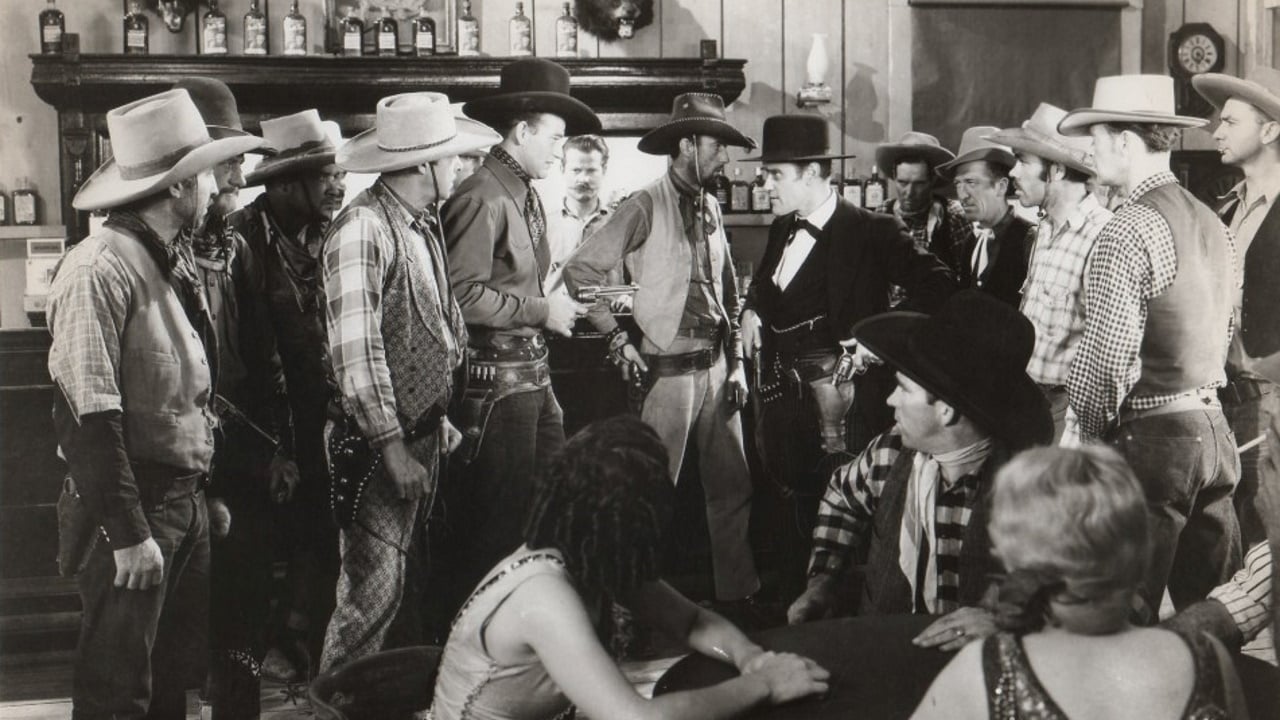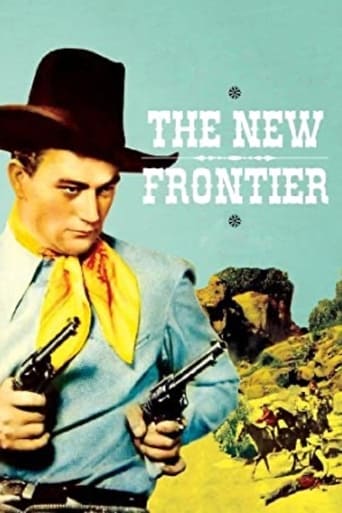

A must for serious John Wayne movie collectors. It is available on John Wayne Matinée Double Feature No. 4 with Sante Fe Stampede (co-starring, the Duke, as one of the Three Mesquiteers).Why aren't these titles on DVD. I have all four of this collection and both the video and sound are more than satisfactory. This early one, He becomes the Sheriff after his father is killed. He and his buddy, Al Bridges (of Preston Sturges fame ) clean up the town with a tremendous saloon shootout. A twist is Al is the leader of a gang of outlaws who the Duke deputized. Being a Republic, rather than a Lone Star makes this one better than most of this period of the Dukes B-Westerns.
... View MoreJohn Wayne was so busy grinding out these western quickies in the days before Stagecoach that maybe he forgot around 1939 to tell Herbert J. Yates that they already had done a film entitled The New Frontier. The Duke has two films for Republic with that title. The second The New Frontier is the last of his Three Mesquiteer films and has Jennifer Jones as his leading lady under her real name of Phyllis Isley. It's possible Yates thought that the first The New Frontier was so bad that he wanted a chance to redeem the title. The Three Mesquiteer film is better than this one that came out four years earlier.John Wayne is a trail boss, according to the film, a vanishing breed. He and father Sam Flint are doing this line of work, bringing in settlers to the new Oklahoma territory. It will be Wayne's last job before he settles down in the new Oklahoma town of Frontier. Problem is that gambler/saloon owner Warner Richmond wants a wide open town. The good citizens of Frontier hire Flint as a sheriff to clean up the place, but Flint gets back shot. Wayne takes his place, in the same way Tom Destry Jr., stepped into his father's profession in Destry Rides Again.Wayne gets help from an old outlaw, Al Bridge, in his efforts. Bridge's life was saved by the Duke on a previous occasion and for an outlaw, he's a man of honor.Except for Al Bridge who later became a Preston Sturges regular, the acting is kind of stiff. Granted that B westerns of the day were usually in some never never land west, but I think even the Saturday afternoon kid crowd knew that wagon trains had died out a generation ago with the coming of the railroad. Wayne in fact takes a specific route from Kansas to Oklahoma the long way around to bypass hostile Indians. There weren't any hostile Indians then. In fact any school kid knew that Oklahoma was the place the formerly hostile Indians got dumped.What the film lacks in authenticity it makes up for in the final fifteen minutes as the Wayne/Bridge crowd starts shooting it out with Richmond's bunch. In fact a fire in the saloon makes this one blazing shootout.The New Frontier is one of a minority of films that never came out on VHS or DVD of John Wayne's. Let's hope the Wayne family estate keeps it under wraps.
... View MoreJohn Wayne stars as trail guide turned sheriff out to bring law and order to a small town. The local troublemaker in the town has shot Wayne's father in the back, establishing Wayne's motivation to take the job of sheriff.The film is short -- 54 minutes -- and has an average story line. There are no surprises here, and the acting...well, the acting is wooden in most cases, even Wayne. Of course, all he had to do was play himself. The one exception is Al Bridge, who plays the head of a gang of thieves who was once nursed back to health by Wayne and so feels that he owes him a debt -- even if it goes against his lawless nature. Bridge plays the part well, even a little tongue-in-cheek, seeming to be smirking just below the surface in every scene.As stated, the story line is predictable so there is no standout here either. The one thing that did impress me was the filming of the obligatory "big shootout" that ends the film. It is several minutes long -- between 10 and 15 minutes -- and is shot at night. In the course of the shootout the saloon is set on fire which quickly jumps to several more buildings. Early films were not known for the quality of night photography, so to see how well this fire was depicted in the film, the quality of the scenes, the staging -- everything was done well in my opinion. Cinematographers Harry Neumann and Gus Peterson did an excellent job of shooting this finale. If you are a film buff, you'll want to check out the film simply for this alone. Others might want to watch one of Wayne's earlier work. Otherwise, the film is an average western.
... View MoreA lot of 1930's B-Western movies are almost embarrassing to watch in their primitive acting and scripting. This one has plenty of both but I found myself hanging to to see how they would being about the expected happy ending. John Wayne's character sets about the task of avenging his father's death while ridding a town of it's lawless element. Of special interest is the juxtaposition of the prayer meeting lead by the parson with the gunfight between the lawless element and the town's menfolk led by Wayne. A lot of movies, even today, shy away from religious themes that involve actual religious characters but this one shows the irony prayerful words against a backdrop of killing and the burning of the town. Take a look if you get a chance.
... View More